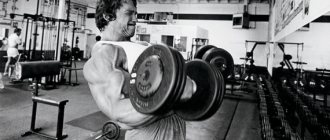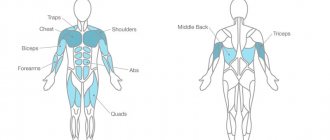From this day on, Zozhnik strengthens the direction of strength training with regular translations from the cult American website T-Nation, where the word “testosterone” is hidden behind the letter “T”. Today translation of the text “8 most effective training splits”.
To begin with, we will provide a link to the text “Full body or split” - for those who want to once again make sure, based on scientific research and expert opinions, that split is for them.
There are so many split options (distribution of exercises across days of the training week) that it can be overwhelming. But the program must be chosen for a specific purpose - and taking into account your level of training and individual characteristics. Let's look at 8 different schemes that effectively solve specific problems; choose what suits you.
Split by body part
This is the most common option in bodybuilding - frequent training (up to 5-6 times a week), each of which works specific muscles.
Pros: You load a muscle group rarely, but with concentration and intensity, performing more different exercises. This “shock” causes the muscles to grow, especially if you have previously trained in a full-body program. This is the best way to gain mass, but due to the increased volume and metabolic stress, it is suitable for experienced bodybuilders who are prepared for heavy loads.
Cons: You have to give up multi-joint exercises, since some muscles work in different movements and do not have time to rest between workouts.
You need to carefully monitor your diet and daily (sleep) routine in order to fully recover and tolerate training loads.
Split by body part takes a lot of time and is not suitable for people with a flexible work schedule - each workout loads its muscles, you cannot skip it. The goal of such a program is hypertrophy, it does not improve the performance of athletes and is not suitable for beginners.
Split example
Monday: Chest Tuesday: Back Wednesday: Shoulders Thursday: Legs Friday: Arms and Abs Saturday and Sunday: Rest
Mass training program
A mass training program has only one goal - to build muscles and increase their volume. Of course, this will be much easier for beginners, since at the beginning of the journey the body has a large margin for growth. But professionals have to sweat for every new millimeter of muscle. To achieve the goal in mass recruitment, two things are needed:
- A well-designed training program
- And a lot of muscle building calories
Mass training program
Without them, you won’t see results, and if there are any results, it will take much more time and effort. And our task with you in training is to give it your all. As one of the greatest natural bodybuilders, McRobert Stewart, said: “If you take the time to train, you will get the most out of it.” This does not mean spending several hours in the gym and doing all the exercises you know. It's about the effectiveness of the workout itself, choosing the right exercises and performing them with the right technique. But not all people are suitable for mass training. We are talking about overweight people. At the beginning of their journey, they need to get rid of excess fat. Therefore, they are more suitable for fat-burning workouts. And then they themselves will decide whether they need muscle mass or not.
Top-bottom split
This scheme is a step from full body training to sectional splits. You increase the volume of exercise for the upper and lower half, but at the same time recover better. Over the course of one week, you can do 4 alternating workouts.
Pros: Top-bottom splits help you progress when full-body workouts have run their course. You continue to develop strength and gain mass. You can train more often, but use decent weights.
Cons: Many people get too carried away with their top workouts and become complacent with their bottom workouts. Since the same groups are worked more often, muscle recovery is worse than in a body part split. Heavy leg training twice a week can be taxing on the body and isn't for everyone.
Split example
Monday: Top (pressing exercises) Tuesday: Bottom (squats and variations) Wednesday: Complete rest or active recovery Thursday: Top (pulling exercises) Friday: Bottoms (deadlifts and variations) Saturday and Sunday: Rest
Split workout for girls in the gym
Consider a three-day cycle of classes. We remember that every workout must be preceded by a warm-up and finished with a cool-down. Warm-ups can include squats, running, jumping rope, etc. During your cool-down, it's best to focus on stretching exercises - this is known to help relieve muscle pain the next day.
Rest between sets should be 30-60 seconds, between types of exercises - 60-120 seconds.
First day - “legs-abs”:
- squats with a barbell on the shoulders - 3 sets of 15 repetitions;
- leg press - 3 sets of 15 repetitions;
- deadlift - 2-3 sets of 12-15 repetitions;
- leg raises on the horizontal bar - 3 sets of 15 repetitions;
- crunches on a Roman bench - 3-4 sets of 15-20 times.
Second day - “chest-shoulders-triceps”:
- dumbbell chest press - 3 sets of 12-15 repetitions;
- push-ups from the floor - 3-4 sets of 20-25 times;
- dumbbell flyes - 3 sets of 10-12 reps;
- lifting dumbbells to shoulder level - 2-3 sets of 12-15 times;
- arm extension (using a block) - 3 sets of 15 repetitions.
Third day - “back”:
- pull-ups - 2-3 sets of 20 times;
- overhead pull-down (behind the head) - 3 sets of 15 times;
- dumbbell rows to the waist (alternating) - 2 sets for each arm, 15 repetitions;
- hyperextension - 3 sets of 12-15 repetitions;
- barbell row to the waist - 2 sets of 10-12 reps.
Full body workout
To be fair, “full body training” is not exactly a “split”, but for the harsh and brutal T-Nation authors, it seems that full body training is just one of the varieties of split - approx. Zozhnik.
Working out the whole body in each workout is more effective if you have little time, and also healthier, because our body is still one whole, and not a collection of parts.
Pros: High-frequency full-body workouts help you lose weight and build strength by increasing the muscle size that grows with frequent stimulation.
This program is better for athletes who have other training besides iron. It teaches the body to optimally perform a small set of movements, rather than wasting effort on a dozen variations of movements.
Beginners should start with these workouts; they burn a lot of calories, lay a strength foundation, and improve health.
Cons: According to the authors of the text, hypertrophy of muscles that require a large training volume is not effective enough. Experienced strength athletes don't recover if they squat heavily three times a week.
Some muscles may be delayed in development, which is not suitable for bodybuilders.
This is a good option for rare workouts - up to 3 times a week. To go to the gym more than three or four times a week, you need to know your body well and control the intensity.
Split example
Monday: A. Rack clean 5x3 B. Bench press 3x6 C. Lunges 3x8-12 D1. Farmer's walk 3x30 seconds D2. Dips 3x 30 seconds
Tuesday: Rest
Wednesday: A. Push press 5×3 B. Deadlift 4×6 C. Pull-ups 3×8-12 D1. Plank 3x30 seconds D2. Dumbbell curls 3x 30 seconds
Thursday: Rest
Friday: A. Back squat 5×3 B. Bent-over row 4×6 C. Dumbbell bench press 3×8-12 D1. Farmer's Walk with one kettlebell overhead (one kettlebell in the lower arm as usual) [KettlebellCrosswalk] 3x30 seconds D2. Glute bridge on a 3×12 bench
Saturday and Sunday: Rest or general physical training.
Program 1[edit | edit code]
Workout 1. Monday[edit | edit code]
- Bent-over barbell or dumbbell rows (or lower block rows to the stomach, can be alternated from workout to workout) 3x8-10
- Pull-ups (or rows of the upper block to the chest) 3x8-10
- Pull down the upper block with straight arms 3x8-10
- Standing biceps curl 3x8-10
- Hammer dumbbell raise 3x8-10
Workout 2. Wednesday[edit | edit code]
- Back squats 3x8-10
- Leg presses in the machine 3x8-10
- Leg curls in the machine 3x8-10
- Seated chest presses in a Smith machine 3x8-10
- Dumbbell raises (swings) through the sides up 3x10-12
- Bent-over dumbbell raises 3x10-12
Workout 3. Friday[edit | edit code]
- Bench presses on a horizontal bench 3x8-10
- Dumbbell flyes lying on an incline bench 3x8-10
- Crossovers on upper blocks 3x10-12
- Close grip bench press 3x8-10
- Arm extensions on the upper block 3x10-12
Explanations for program 1[edit | edit code]
The undoubted advantage of this program is the time savings. For example, on Monday, after back training, in which the biceps have already received a serious load and have warmed up well, you can start training the biceps with virtually no warm-up. For the same reason, a couple of approaches of one exercise may be enough to fully work out the biceps. The same considerations apply to training your triceps on Friday. If there is a feeling of muscle congestion after this couple of approaches, then it is pointless to continue training it that day.
Press/pull split
Here you divide exercises by type of movement: pressing and pulling. Most of the muscles in the back of the body work in rows, and in the front - in presses.
Pros: The push/pull split is good for those who want to train hard but are limited in time. You can practice the movement more often than in a body part split, which only hits muscle groups once a week.
Cons: Due to the distribution of the load across muscle groups working together, it is not suitable for athletes and beginners who still find it more effective to work the entire body at once. To benefit from this split, you need to have some training experience.
Split example
Day 1: Rows (upper back, spinal flexors, hamstrings, biceps) Day 2: Presses (chest, shoulders, triceps, quads, abs)
Three day split
For people who lead an active lifestyle and take care of themselves, a new training system has been developed, thanks to which it is possible to pay attention to each muscle group and achieve the desired results in a short time.
The three-day split is the latest development of training techniques, thanks to which it turns out to combine all muscle groups so that the athlete manages to use every muscle of his body in one set of exercises. Thanks to this, they are grouped in time and begin to work. The main thing is the right approach in this matter, and then the work of each muscle group will be built in the right way. To achieve this kind of results, you need to work hard and fulfill two simple conditions: pay attention throughout the training to small and large muscle groups, and learn to combine these muscle groups so that these same muscles become antagonists. The most reliable methods of training would be to combine such muscle groups as: chest and biceps, back and triceps, and legs and shoulders.
The result of such a properly organized training day will not take long to arrive! After all, first of all, the basic conditions of such training (which are described above) will be fulfilled. During the first training day, the athlete pays attention to the chest and biceps, in which case the chest acts as a large muscle group, which makes it follow it, and the biceps is a small group that follows the superior one. The largest muscle group of muscles goes to the human legs, and the shoulders remain to perform their main function only when walking or when the athlete does push-ups from the floor on his hands or while standing on the horizontal bar. And no matter how strange it may sound, in this case the shoulders are a large small muscle group, and thanks to training the legs, special hormones are released into the human body, which is why many recommend training the shoulders and legs together. You need to pay attention to the fact that you should always start training a large muscle group at the very beginning of the workout, and a small one at the end.
Why is a three-day split the most effective and beneficial?
A large amount of time for rest and recovery - such a significant advantage is that the interval between training large muscle groups is quite large. It lasts approximately about a week, it helps not only beginner athletes, but also professionals gain strength and get in shape. More experienced athletes can independently distribute the level of load and divide training into several levels: light, medium and heavy. This helps the athlete strengthen absolutely all large muscle groups and bring the moment of their super compensation closer before each start of a new training day. You should not then think that the chest can be trained on the same principle as the legs. It will be necessary to divide the exercises with the legs into light, medium and heavy, and for the chest, choose only light and heavy levels of load. To achieve supercompensation of all muscle groups, you need to be very careful during exercise, and the athlete will also need to keep his own training diary, in which he can note all the techniques that are used during exercise and which muscle groups are trained on a given day. Keeping a diary will help you monitor the gradual achievement of results, and, if necessary, make corrections to the training process.
The schedule for preparing training days is suitable for any athlete - this advantage was written about above. Now the emphasis is on what exactly this kind of difference is connected with. The whole point is that during training, muscle mass increases, and naturally, it will need a significantly longer time to recover. The principle is that if a muscle becomes large, then it needs more time to recover! The recovery process for the muscle is necessary because with each training the athlete plans to increase the load on his muscles; this is the only correct solution to force the human body to hypertrophy muscle mass. If there is no constant increase in loads, then the body will consider it necessary not to increase the volume of muscle tissue, and the process will stand still. In order to be able to increase the weight on the bar each time, the athlete needs to train precisely at the moment of supercompensation. Please note that if the athlete’s attempts to increase the load are successful, then this scheme works great. There are no special schemes that would not work, you just need to use them wisely at a certain time, and you should only think about changing the training process if the previous training option does not allow the athlete to grow further.
Training small muscle groups should occur twice a day - this distribution is obtained as a result of a special grouping of muscle tissue during the split (it was written about above). There is no doubt that when an athlete trains the chest muscles, then the entire load will be applied to the triceps, and if the back receives the load, then the biceps will also be trained. After all, it is as a result of training large muscle groups that the triceps and biceps are rewarded with surface load, this helps create the conditions for their micro-periodization. It is best to train all large muscle groups only once a week; this is very suitable for those athletes who are just starting training, since they do not yet know how to correctly distribute the load on all muscle groups, but only change the degree of load. As a result, the training schedule gets confused, results are achieved slowly and the athlete remains dissatisfied and puzzled.
Significant disadvantages of this type of training
It does not provide for the necessary specialization - this disadvantage is associated with a reduced number of classes, as a result of which it is difficult for an athlete to allocate time for training a certain muscle group. There is no doubt that the muscles will react and work better if the athlete focuses only on certain muscle groups throughout the entire session. This is closely related to the limited capabilities of the human body, which concerns the direct supply of all necessary elements and the endocrine system. Most likely, the human body will restore large muscle groups first, which is why it is best to train the shoulders together with the legs, since they are the largest and smallest muscle group at the same time. Well, if you decide to train your legs along with your biceps, it may happen that your strength simply runs out. When an athlete has a lot of experience, it may also happen that there may not be enough resources to train small muscle groups, then it is best to postpone this activity until the next day or week.
There is not enough space for deadlifts - this awkwardness lies in the fact that the training of the back muscles is divided into two main parts - this is training the long muscles of the back and training the latissimus muscles of the back. If you start working on both back muscles at once, you will not see any results. The right way out in such a situation would be to organize a joint workout, at the end of which it would be advisable to do the main deadlift. The deadlift is the hardest and most effective exercise for joints, but often there is no longer enough strength for it. If you start developing long muscles at the very beginning of training, then during exercise the broad muscles of the spine they will receive a very large load, since tired long muscles will not be able to withstand the entire load on themselves. Therefore, for such an intense and difficult workout, it is necessary to carve out a separate day.
THREE DAY SPLIT – DAY 1
What can replace this kind of load?
The first method - during this type of training, the athlete needs to do a joint workout of the chest and triceps, back muscles and biceps, leaving only the load on the legs and shoulders from the previous proposed method. The basis of such training is targeted work only with large muscle groups, and small muscle groups are taken on only at the end of the session with special isolating exercises. The advantage is that he devotes the bulk of his energy only to the development and training of large muscle groups, which will make it possible to better develop and increase the total muscle mass. One disadvantage is that with such training, little attention is paid to the hands.
The second method - the proposed type of training places the main emphasis on arm training. During such classes, the athlete does a joint workout of the legs and chest, back and shoulders, and is left with one free training day, which is completely devoted to arm exercises. The advantage of such training is that all exercises are aimed at strengthening the athlete’s upper body, since during classes for the legs and chest, all the loads performed are performed only to improve the functioning of the endocrine system. As a result, this type of training will help you develop without problems and progress only for the better. This happens because the athlete devotes a very large amount of time to arm exercises. As a result, after some time the arms gain good muscle mass. This workout is suitable for those who have already gained a lot of muscle mass and are ready for further development. The only drawback is that now practically no attention will be paid to the legs.
The third method is a joint exercise of the following muscle groups: chest and shoulders, legs and biceps, back and triceps. The best results from such training can be achieved while lying down. In this case, the shoulders are sacrificed, and if you focus on the legs, the biceps are immobilized. But, despite this, such training makes it possible to devote a lot of time to the legs and at the same time maintain the tone of the biceps. So this helps restore the delta for each subsequent workout, which will be aimed at the chest. But when the lesson comes to the legs and shoulders, the front deltoid can slightly hinder the athlete’s development in the bench press. It was not possible to discover the most striking benefits from such training. But, despite this, this scheme can be used by those who want to pump up their legs and strengthen their chest muscles.
Recommendations
The three-day split aims to increase muscle mass during intense physical activity. The greatest results can be achieved if you use this scheme systematically and follow all the necessary rules. Such training will help the athlete gain a fairly large amount of muscle mass, but in order not to lose it, you need to train hard, otherwise the body itself may decide to burn muscle fibers that are very necessary for it. For better and faster muscle mass gain, it would be better to adhere to a special diet - a bodybuilding diet. It contributes to the creation of an excess of calories, which is the main source of the anabolism process. The main thing is to understand the fact that taking proteins, vitamins and regular nutrition will not help achieve the desired result. To gain muscle mass, you need an excess of nutrients that are actively involved in the formation of new muscle tissue, as well as regular training and physical activity.
The main thing in successful training is a properly organized training system, correct load modes, as well as long rest to recuperate. That is why it is often recommended to use the most basic and basic exercises during basic split training, and only later begin to include isolating exercises in the training process. This happens when the basic ones are not enough to gain muscle mass. The minimum rest between sets is about a minute. This pace of exercise will better stimulate hypertrophy of muscle tissue. You also need to know that all bodybuilder training is very long and voluminous. On average, a lesson can last from forty to fifty minutes. Therefore, it turns out that the athlete does not have much time left for rest.
Three-day split training scheme
The standard approach is chest and biceps, back and triceps, legs and shoulders. Chest and biceps Bench press - exercise performed four times for ten repetitions Angle press - four times for twelve repetitions Dumbbell flyes - three times for fifteen repetitions Biceps curls Hammers times for twelve repetitions of the exercise.
Back and triceps Barbell rows - perform the exercise four times for twelve repetitions Wide-grip pull-ups - three times as much as you can Shrugs - three times for twenty repetitions Close-grip press - four times for twelve repetitions Standing French press - three times for fifteen repetitions.
Legs and shoulders Squats with a barbell - the exercise is performed four times for twelve repetitions Leg press - three times for fifteen repetitions Calf raises - three times for twenty repetitions Seated press - three times for twelve repetitions Barbell rows to the chin - three times for fifteen repetitions.
Alternative for the first method of training replacement: chest and triceps, back and biceps, legs and shoulders Chest and triceps Bench press - perform the exercise four times for ten repetitions Angle press - four times for twelve repetitions Reverse push-ups - three times for twenty repetitions French press lying down - four times twelve repetitions.
Back and biceps Barbell rows - perform the exercise four times for twelve repetitions Wide-grip pull-ups - three times to the maximum Shrugs - three times for twenty repetitions Hammers - five times for twelve repetitions.
Leg and shoulder training remains the same.
The second alternative way to perform exercises is legs and chest, back and shoulders, arms.
Legs and chest Squats with a barbell - perform the exercise four times for fifteen repetitions Bench press - four times for eight repetitions Angle press - four times for twelve repetitions Pullover - four times for fifteen repetitions.
Back and shoulders Barbell rows to the waist - perform the exercise four times for twelve repetitions Wide-grip pull-ups - three times Barbell rows to the chin - four times for fifteen repetitions Shrugs - three times for twenty repetitions.
Arms Bicep curls and close grip presses – perform four super sets of 12 reps per exercise Dips and barbell curls – three sets of 12 reps French press and hammers – three sets of 15 reps per exercise.
REVIEW OF THE BEST TRAINING PROGRAMS
REVIEW OF THE BEST TRAINING PROGRAMS
Igor June 2, 2015
Intensive/extensive split
In this scheme, the load on the nervous system varies, i.e. high intensity and volume. After a day of hard/speed training comes a day of longer, but less intense training. You can exercise 3 or 4 times a week.
Pros: An advanced option for athletes who have already exhausted regular full-body workouts. In addition to the physical fitness and strength supported by traditional loading, you work more on speed and power, improving performance in your sport.
Cons: This split is only for experienced ones; it requires a strict dosage of loads. Workouts on an intense day last longer because you need to rest a lot between sets of power exercises. This scheme stimulates hypertrophy less.
Split example
Monday: Acceleration exercises, weightlifting and other pushing exercises Tuesday: Metabolic training, pulling exercises Wednesday: Rest Thursday: Acceleration exercises, weightlifting and other pushing exercises Friday: Metabolic training systems (GPP), traction exercises Saturday and Sunday: Active recovery
Key Benefits of Split Training
♦ DURATION OF TRAININGS. During the training process, a limited number of muscles are loaded, so the training duration is reduced to 40-60 minutes, in addition, the muscles are fully loaded, but without reaching the stage of overtraining;
♦ INTENSITY OF THE CLASS. It's easier to focus on a specific muscle group than working the entire body. Of course, in this case, the selected muscle area will be worked out more efficiently and effectively.
♦ CONCENTRATION. Since the duration of the training is reduced to 60 minutes, it is much easier to tune in to training a specific area, which cannot be said for the duration of the load for 1.5-2 hours.
Split “agonists/antagonists”
In one workout, you work muscle groups that perform opposing movements, such as dumbbell bench press and dumbbell chest row.
Pros: These supersets lead to balanced development of strength in presses and rows. Alternating approaches for agonists and antagonists helps to increase working weights; increased blood flow to working parts of the body causes additional hypertrophy. The workouts are shorter and can be done more often – up to 6 times a week.
Cons: Not suitable for athletes who need to concentrate on specific movements. For beginners and older people, such loads are too great and require more recovery time.
Split example
Monday: Chest/Back Tuesday: Legs/Shoulders Wednesday: Rest Thursday: Chest/Back Friday: Biceps/Triceps Saturday and Sunday: Active recovery or complete rest
Who is the split suitable for?
Split training involves detailed work on each part of the body and is designed for advanced athletes. For a beginner, it will simply be too difficult to work on one or two body parts for 30-40 minutes.
For girls who have recently started visiting the gym, a circuit training program is better suited. After a few months, the body will adapt to the stress and it will be possible to move to the next level. Training based on the principle of separating muscle groups requires sufficient preparation and the ability to perform basic exercises.
Split is not suitable for those who often have to skip workouts and are not ready to work out according to a specific schedule. Discipline and strict adherence to frequency are important here.
Regardless of your level of preparation and schedule, you need to choose a specific training program individually. It's better to spend some time experimenting and finding what really suits you. You can try the circuit principle and try splits. This way you will decide which training method is right for you.
Many people find it difficult to choose a training system for themselves. If difficulties arise, you can contact a coach who develops programs for girls. It is quite possible that you will like the program with split elements the most.
Split “main/additional movement”
The training combines exercises for large muscle groups and for small synergists that help with the main movement. For example, back and biceps or chest and triceps.
Pros: You can train often (3-6 times a week) and briefly, using supersets. The same muscle groups work longer, which leads to hypertrophy.
Cons: Too heavy for beginners and not suitable for seniors as they require more rest. This split is best used by experienced athletes who understand what they need to work on.
Example split for 5 workouts per week
Monday: Back/Biceps Tuesday: Chest/Triceps Wednesday: Legs/Shoulders Thursday: Back/Biceps Friday: Chest/Triceps Saturday and Sunday: Rest
Specialization for tightening lagging muscles
For a short period, you leave only one day to maintain the muscles of the whole body and invest maximum effort in developing the weak group (3 times a week or more).
Pros: Increased volume and intensity lead to hypertrophy of the desired body parts. A good technique for experienced people who need to tighten up something sharply.
Cons: All other muscle groups receive only maintenance work and may lose strength/mass. This is not a program that will save all your results; something will have to be sacrificed.
Example of specialization for back muscles
Monday: Low rep horizontal rows Tuesday: High rep vertical rows Wednesday: High rep horizontal rows Thursday: Low rep vertical rows Friday: Full body maintenance workout
How to choose a split?
Determine the main goal of your training
Decide what exactly you need to improve. Isolation splits are not suitable for athletes who need to improve performance in full-body movements.
If you need muscles, don't waste time on jumps and sprints that develop speed. Choose one main goal, and you will know what split to take.
Rate your busyness
Everyone has 7 days in a week and 24 hours in a day, so decide how much you can spend on training. I had a client with three kids and four 12 hour shifts - and he could train 3-4 times a week.
Set your priorities. If you don’t have time for 5 workouts for 2 hours, then do a full body program. Any program will produce results if you can follow it.
Training Experience
This is a very important factor for choosing the right circuit. Beginners sometimes start straight away with a body part split, but they have too little strength and experience to benefit from isolated muscle work. Older people find that they cannot do much heavy training: the nervous system gets tired, the joints are overloaded, etc.
Recovery
Our body is a collection of different systems. It is necessary to monitor not only muscle recovery, but also take into account work stress, mental state, quality of sleep and nutrition.
Read on Zozhnik:
The most expensive fitness rooms in the world
Why thermal belts and wrapping with cling film are harmful
3 Ineffective and Harmful Ab Exercises
43 Little-Known Photos of Arnold Schwarzenegger
All daily diets and recipes with KBJU
Building a lesson
Any workout can be broken down into components. This is a warm-up, a working part and a post-workout cool-down. Also below is an example of a three-day split program.
Warm-up
Even if you train one or two zones, you need to warm up your whole body before exercise. Warm up for 5-7 minutes. You can work out on a cardio machine or perform a standard joint warm-up, which many remember from school physical education lessons (circular rotations with arms and legs, head turns, mill, squats, etc.).
Main part
To begin with, here are the general principles of doing the exercises.
- To tone muscles and maintain shape for each part of the body, it is enough to do 3-4 exercises of 12-15 repetitions in 3 sets. Choose a medium weight to feel the load. Rest between sets is 40–60 seconds, and between exercises – 1.5 minutes.
- For girls who are working on body definition and losing weight, it is recommended to work with small weights with a higher number of repetitions (15–20, in some exercises can be increased to 20–25). In this case, the pace should be kept slightly above average, and the rest between exercises should be reduced if possible.
- When working on mass, on the contrary, you need to increase the working weight to close to the maximum (for beginners to slightly above average), reducing the number of repetitions to 8–12. You should rest 60–90 seconds between sets and 2.5 minutes when changing exercises.
Whatever your training goals, proper technique plays a huge role. Improper execution of movements is not only ineffective, but also dangerous, especially when working with weights.
The cycle phase is important in girls’ training. At the beginning of the month, you can increase the load, try new exercises and devote more time to aerobic exercise. In the second half of the cycle, it is worth giving the body a rest from intense exercise and, if you feel unwell, reduce weight or reduce repetitions.
Example program
The following program is provided as an example. You can make changes to it in accordance with your individual characteristics - work schedule, favorite exercises and level of training.
Day 1: legs/buttocks and abs
- Squats with a barbell or bodybar (for beginners). Wide stance of the legs, toes pointing diagonally.
- Lunges with dumbbells.
- Romanian style deadlift (Romanian deadlift).
- Calf raises in a machine or with dumbbells.
- Hanging leg raises for abs. Perform as many repetitions per set as you can.
- Twisting the body on an incline bench.
- Plank. Try to increase the time spent in the plank pose from 30 seconds to 2 minutes per approach.
Day 2: back and biceps
- Pull-ups. If you can’t do a single pull-up, use negative reps. That is, you rise to the top point by standing on a pedestal or bench, and from there you slowly lower your body using the muscles of your back and arms. Do as many repetitions as you can.
- Pull of the upper block behind the head.
- Barbell row to the stomach.
- Row a dumbbell to the waist with each hand alternately. We count the number of repetitions and approaches for each hand.
- Hyperextension.
- Curling arms with dumbbells for biceps.
Day 3: Chest, Triceps, Shoulders
- Push-ups with wide arms. If you cannot perform the required number of times, simplify the exercise by standing on your knees.
- Dumbbell bench press.
- Dumbbell raises.
- Standing overhead dumbbell press.
- Standing dumbbell lateral raises
- Reverse push-ups.
- Extension of arms for triceps in a block simulator.
Finishing the session and stretching
For girls who want a toned and slender body, final stretching is very important. It helps relax muscles and calm breathing. Skipping stretches will lead to severe muscle pain the next day. If you sabotage stretching regularly, the muscles will become stiff and the likelihood of injury will increase. You can use a short yoga routine or classic stretching movements.
Focus on the muscles you worked on, but don't forget about the rest of your body. Your session also involved a lot of stabilizer muscles. You need a comprehensive stretching program that you can repeat after each session.
On average, each split workout takes from 30–40 minutes to an hour. The duration depends on how long you rested between reps and exercises.
Split is ideal for those girls for whom circuit training is not enough to get the desired results. The program can be compiled independently or with the help of a trainer. Due to the fact that only certain muscle groups are worked out in one session, the workout will not take much time and will be very intense.











